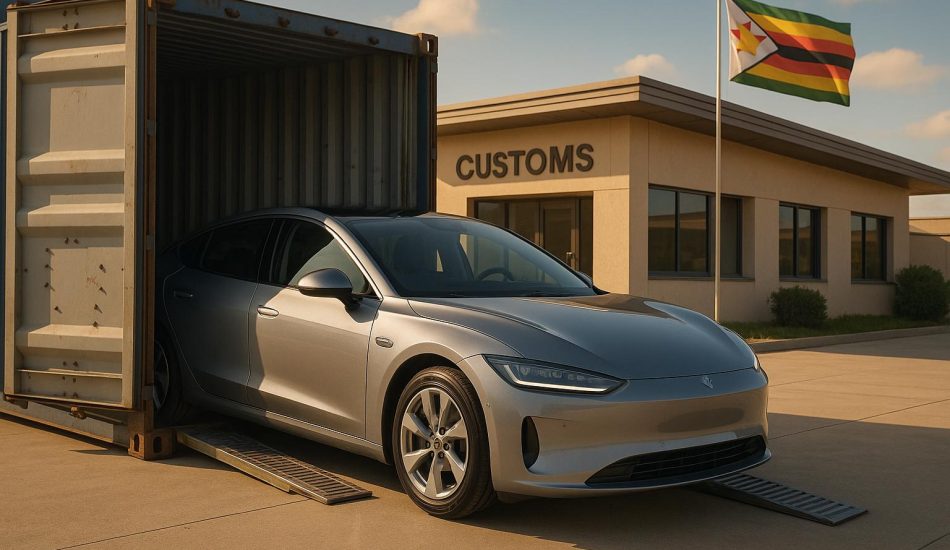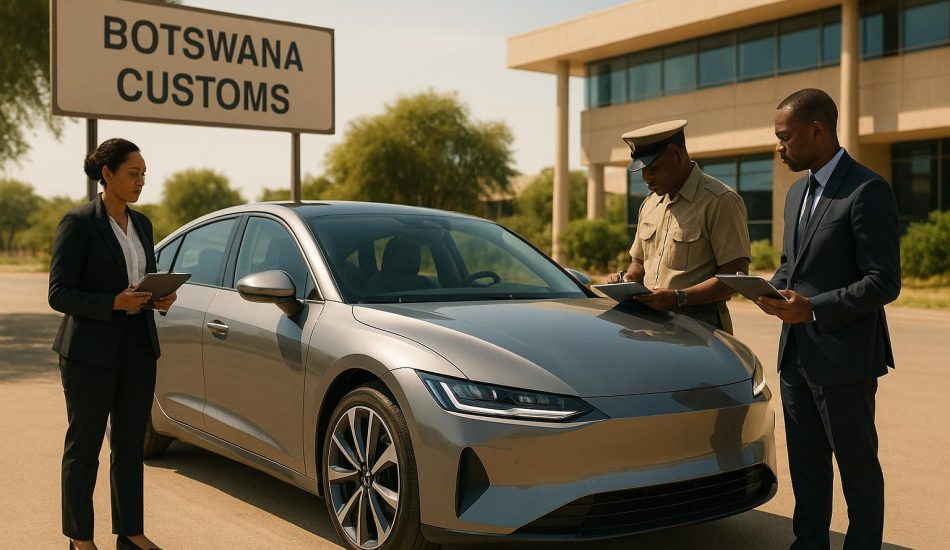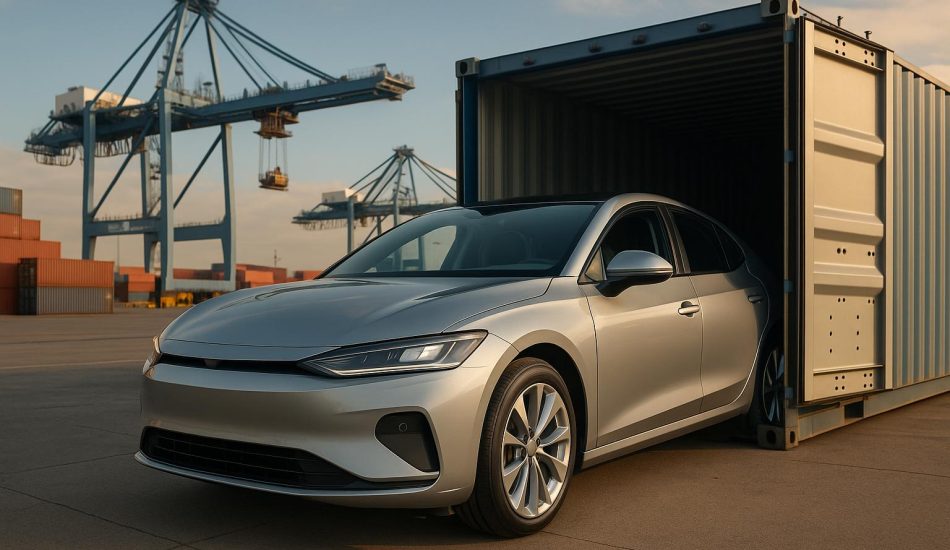
Namibia has introduced new rules for importing electric vehicles (EVs) in 2025, aiming to boost EV adoption and meet ambitious clean transportation targets. With only about 100 EVs currently on the road, the country plans to convert 96,500 light vehicles to EVs by the end of the year. Here’s what you need to know:
- Key Import Rules: Only right-hand-drive EVs under 8 years old are allowed. Compliance with safety and technical standards is mandatory.
- Step-by-Step Process:
- Choose a compliant EV model (e.g., Tesla Model 3, BYD SEAL 06 GT, Hyundai IONIQ).
- Purchase through reliable platforms like EV24.africa, which handles sourcing, shipping, and certification.
- Prepare required documents: import permit, passport, invoice, and bill of lading.
- Ship the vehicle, clear customs, and register it locally.
- Costs: Import duties range from 15% to 30% of the vehicle’s CIF value, with shipping costs averaging $2,150–$2,250.
- Charging Infrastructure: A new regulatory framework launched in April 2025 ensures standardized and safe EV charging setups.
Namibia’s updated regulations simplify the import process while supporting the country’s clean energy goals. Platforms like EV24.africa make it easier for buyers to navigate these changes, offering end-to-end services, financing, and EV-specific insurance.
Bravo Namibia – Electric Vehicles Namibia
How to Import an Electric Vehicle: Complete Process
With Namibia’s updated 2025 EV import rules, the process has been streamlined into three main phases: selecting a compliant model, purchasing it, and completing shipping, certification, and registration. While the framework simplifies much of the process, understanding each step is crucial to ensure a smooth experience. Start by confirming that your chosen EV meets Namibia’s import standards before moving forward with the purchase.
Choosing a Compliant EV Model
The first step is to make sure the vehicle you choose adheres to Namibia’s strict compliance standards. Only right-hand-drive vehicles are allowed, as left-hand-drive vehicles are prohibited unless imported by diplomats. Additionally, vehicles older than eight years cannot be imported, so it’s essential to verify the manufacturing date.
Your selected model must also meet international standards for key components such as batteries, inverters, motors, and software. Popular models that comply with these requirements include the Tesla Model 3 and Model Y, BYD SEAL 06 GT, Hyundai IONIQ series, and various Suzuki electric models. Certification involves thorough inspections and detailed paperwork to ensure the vehicle meets safety and software security protocols.
Finding and Buying Your EV
Once you’ve identified a compliant model, the next step is to source your vehicle through a reliable platform. One such marketplace is EV24.africa, which specializes in importing electric vehicles and provides support throughout the buying process. The platform offers both new and certified pre-owned models from leading brands like Tesla, BYD, Leapmotor, ROX, Dongfeng, Geely, Hyundai, Toyota, and Suzuki.
EV24.africa ensures all vehicles are certified before they arrive in Namibia. They provide detailed specifications, transparent pricing, and financing options in all-inclusive packages. These quotes cover the vehicle’s cost, shipping, customs clearance, and registration fees, making the process more straightforward.
Many customers have shared positive experiences with the platform. Johan M. from Windhoek shared:
"I never thought importing a car could be this simple. I tracked my Tesla from Shanghai to Windhoek. EV24.africa handled it all!"
Once your purchase is finalized, you’ll move on to the shipping, certification, and registration phase.
Shipping, Certification, and Registration Steps
After purchasing your EV, the final phase involves shipping and registering the vehicle. Before shipping, you’ll need to secure a valid import permit as required by the Import and Export Control Act.
The customs process requires several documents, including your import permit, passport, invoice, registration papers, and the original bill of lading. The bill of lading must include details such as the vehicle’s brand, chassis number, model, year of manufacture, and engine number. Ensuring these details match the bill of entry is crucial to avoid delays at customs.
EV24.africa offers two delivery options to suit different needs. The port-to-port option allows you to collect your vehicle from Walvis Bay, Namibia’s main port. For added convenience, the door-to-door option delivers the vehicle directly to your address, handling all logistics. Delivery typically takes 4 to 8 weeks, during which the vehicle undergoes final compliance checks.
Once the vehicle arrives, you’ll need to complete the registration process. This includes submitting all required documents to local authorities and passing final safety inspections. EV24.africa assists with many of these administrative tasks, ensuring the vehicle is certified, registered, and ready to hit the road. Their comprehensive service – from sourcing to final warranty provision – makes importing an EV far simpler and more accessible under Namibia’s updated regulations.
Required Documents and Compliance Requirements
Having all your paperwork in order is crucial – missing even one document can result in delays at customs, as the Ministry of Industrialization and Trade (MIT) enforces strict import procedures. While most import licenses are granted automatically, importing motor vehicles requires non-automatic licenses.
Documents You Need for Importing
Before your vehicle arrives, gather all the necessary documents to ensure a smooth customs clearance process. Start by obtaining an import permit through the IMEX online system. This permit is your official authorization to bring the vehicle into the country.
You’ll need a certified copy of your passport or ID. If you’re not a Namibian citizen, add a residence permit to your list. For companies importing electric vehicles (EVs), additional documentation is required, such as proof of registration with the Registrar of Companies. This might include a certified copy of the Founding Statement, Memorandum of Articles of Association, or Sole Trader Certificate.
On the financial side, you’ll need an invoice or pro-forma invoice detailing the vehicle, along with proof of payment or funds transfer. These documents verify the legitimacy of your purchase and help customs calculate any duties that may apply.
Shipping and vehicle documentation is also essential. This includes the bill of lading, registration papers from the country of origin, and a packing list. Additionally, you must provide a deregistration certificate from the export country. If the certificate isn’t in English, a sworn translator must translate it.
Once all your documents are ready, confirm that your EV meets the required safety and technical standards.
EV Compliance Checklist
In addition to paperwork, imported EVs must adhere to specific safety and technical standards. The Electricity Control Board (ECB) has developed a regulatory framework for EV charging infrastructure, set to roll out in April 2025. ECB CEO Robert Kahimise provided insight into this plan:
In the new financial year starting in April 2025, the ECB will launch the Framework Implementation Plan. This will begin with the adoption of standards in partnership with the Namibia Standards Institute (NSI), followed by a consumer education campaign to help the public understand the Framework and its implications.
| Compliance Category | Requirement | Verification Method |
|---|---|---|
| Safety Standards | Must meet international safety protocols | Multi-stage certification process |
| Component Testing | Batteries, inverters, motors, and software systems | Laboratory testing under global protocols |
| Roadworthiness | Designed for Namibian terrain and climate | Technical inspection |
To ensure compliance, EV24.africa conducts thorough inspections and certifications for every electric vehicle. By working with certified labs and manufacturers, they provide detailed homologation and all necessary compliance documents, ensuring each vehicle meets both local and international standards.
Understanding the ECB and NSI standards set to be implemented in April 2025 will help you stay ahead of the game. This new framework will streamline EV imports and provide clear guidelines for compliance, making it easier for importers to meet regulatory requirements.
Import Costs and Payment Options
Once you’ve navigated the straightforward import and registration process, it’s crucial to understand the financial side of things. Importing an electric vehicle (EV) involves more than just the purchase price. You’ll need to account for shipping, duties, and various fees. Namibia calculates import duties and taxes using the CIF (Cost, Insurance, and Freight) method, which means these charges are based on the vehicle’s value plus shipping costs.
Total Import Cost Breakdown
Bringing an EV into Namibia involves several expenses that can add up quickly. Shipping the vehicle is one of the largest costs after the purchase price. For example, container shipping from the U.S. to Africa typically costs between $2,150 and $2,250 for standard vehicles. In addition, destination charges at African ports average around $400.
Import duties and taxes are another major factor. Namibia imposes a customs fee ranging from 15% to 30% of the car’s value. This fee applies to the CIF value, meaning it’s calculated based on the combined cost of the vehicle and shipping. Additional taxes and duties are also levied on vehicles unless they’ve been owned by the importer for at least one year.
Other expenses include customs broker fees for processing clearance documents and certification costs to ensure the EV complies with Namibian standards. These fees vary depending on the vehicle and specific compliance requirements.
| Cost Category | Estimated Amount | Notes |
|---|---|---|
| Vehicle Shipping | $2,150 – $2,250 | Container shipping from the U.S. to Africa |
| Destination Charges | ~$400 | Includes port handling fees |
| Import Duties | 15% – 30% of CIF value | Applies to vehicle price plus shipping costs |
| Customs Broker Fees | Variable | Covers documentation and clearance processing |
| Certification Costs | Variable | Based on vehicle compliance requirements |
Using electronic document management can help reduce additional shipping-related costs.
Now that the costs are broken down, let’s look at the payment options that make EV ownership more accessible.
Financing and Payment Plans
EV24.africa offers flexible payment plans through partnerships with banks and fintech companies, making EV ownership within reach for more Namibians. Options include installment plans, leasing arrangements, and even mobile money or cryptocurrency payments.
These financing plans are tailored to suit different financial situations. Whether you’re an individual buyer or a business aiming to convert your fleet to EVs, EV24.africa works with you to create a payment structure that fits your budget. This flexibility aligns with Namibia’s ambitious goal of replacing over 10,000 diesel and petrol vehicles with EVs by 2030.
Additionally, EV24.africa has partnered with local insurance providers to offer EV-specific insurance plans with reduced premiums. This integration allows you to bundle financing, insurance, and import services into one seamless package.
Customer feedback highlights the ease of this process. Ndeshi K. from Swakopmund shared:
The BYD SEAL 06 GT I got is perfect for my family. Delivery was smooth and fast.
For personalized financing and insurance quotes, reach out to EV24.africa. Their team can help you understand all costs upfront, ensuring you’re fully informed before committing to your EV purchase and import.
Charging Setup and EV Ownership Guide
If you’re planning your EV charging setup or considering EV ownership under the 2025 guidelines, here’s what you need to know. The Electricity Control Board (ECB) rolled out a regulatory framework in April 2025 to streamline EV charging infrastructure across the country. This framework includes clear rules for installation, regulatory compliance, and pricing for charging stations.
2025 Charging Infrastructure Updates
In collaboration with the Namibia Standards Institute (NSI), the ECB has introduced a framework that ensures safe and standardized charging setups. With EV adoption on the rise, having a reliable and efficient charging infrastructure is more important than ever.
For home charging, hire a licensed electrician who knows local codes, permitting, and inspection requirements. Start by evaluating your home’s electrical system to confirm it can handle a Level 2 charger. If necessary, upgrade your electrical panel. Choose a spot for the charger that is both accessible and sheltered.
The ECB has flagged that home EV charging can put extra pressure on the electricity grid. To address this, they’ve implemented stricter monitoring and load management measures. These steps not only enhance safety but also help maintain EV performance, especially under Namibia’s challenging environmental conditions.
EV Ownership Tips for Namibia
Owning an EV in Namibia involves more than just charging – it requires attention to the country’s unique climate. For instance, in hot desert conditions, where temperatures often exceed 95°F (35°C), an EV’s range can drop by as much as 15%. To minimize this impact, park in shaded areas and try to charge during cooler times of the day. Keeping your tires at the right pressure also helps, as improper inflation increases wind resistance and energy use.
On the flip side, Namibia’s mild conditions around 70°F (21.5°C) are perfect for EVs, allowing them to exceed their rated range by an average of 15%. These conditions are ideal for planning longer drives. Tools like HERE EV Routing can further enhance your experience by helping you map routes that consider battery range, elevation changes, and charger availability.
However, maintenance can be tricky due to limited EV service centers in some areas. Companies like EV24.africa are stepping in to fill the gap. They partner with local service providers and offer warranty support for imported vehicles, ensuring access to skilled technicians familiar with EV models. This is especially important in sub-Saharan Africa, where finding mechanics with EV expertise can be a challenge.
sbb-itb-99e19e3
Summary: Importing an EV in Namibia Made Simple
Bringing an electric vehicle (EV) into Namibia has become a more straightforward process. It involves a few key steps: securing an import permit, meeting local compliance standards, and gathering necessary documents like your passport, invoice, registration papers, and bill of lading.
While import costs include customs duties ranging from 15% to 30% and an additional 15% VAT, the long-term savings can be significant. EVs boast over 85% energy efficiency, with operating costs of about $1.77 per 100 km compared to $7.20 for gasoline vehicles. For someone driving 15,000 km annually, this could mean saving roughly $814.50 each year.
Platforms like EV24.africa simplify the process further by handling sourcing, shipping, certification, registration, and even warranty support, all with clear pricing. They also provide flexible financing options, including installment plans and partnerships for EV-specific insurance.
Namibia’s ambitious goals include converting 96,500 light vehicles to EVs by 2025 and replacing over 10,000 diesel and petrol vehicles with EVs by 2030. The country is also expanding its charging infrastructure. Keep in mind, however, that imported EVs cannot be resold until two years after registration, and a residence permit is required for importation. With careful preparation and the right resources, importing an EV is a practical step toward supporting Namibia’s clean energy future.
FAQs
What are the advantages of using EV24.africa to import an electric car into Namibia?
Why Choose EV24.africa to Import Your Electric Vehicle to Namibia?
When it comes to importing an electric vehicle (EV) into Namibia, EV24.africa offers a seamless and reliable solution. The platform connects you with a wide range of top EV brands, including Tesla, BYD, and Volkswagen, making it easier to find a vehicle that suits your preferences and lifestyle.
What sets EV24.africa apart is its end-to-end service. They handle every stage of the import process – from sourcing the vehicle to shipping and final delivery. This means you can enjoy the excitement of owning an EV without dealing with the usual complexities of importing one yourself.
Additionally, EV24.africa provides transparent pricing and offers flexible delivery options, including through key ports like Walvis Bay. To top it off, they ensure dependable post-purchase support, making the transition to electric vehicle ownership in Namibia as smooth and stress-free as possible.
What do the new 2025 regulations for EV charging infrastructure in Namibia mean for electric car owners?
2025 Regulations for EV Charging Infrastructure in Namibia
Namibia’s 2025 regulations for electric vehicle (EV) charging infrastructure aim to prioritize safety, reliability, and accessibility for EV users. These regulations establish clear guidelines for the installation and operation of charging stations, ensuring drivers can easily locate dependable options to recharge their vehicles.
By providing a structured framework, these rules are set to increase the number of charging stations across the country, minimize uncertainties surrounding the infrastructure, and encourage wider adoption of EVs. For drivers, this translates into greater convenience, easier access to charging points, and a more seamless experience when navigating the roads with electric vehicles in Namibia.
What are the main requirements for importing an electric car into Namibia under the 2025 regulations?
Importing an Electric Vehicle into Namibia Under 2025 Regulations
Starting in 2025, importing an electric vehicle (EV) into Namibia will require meeting several updated standards. These include ensuring your vehicle complies with regulations for battery capacity, vehicle assembly, and safety certifications. Every EV must also go through a thorough certification process to confirm that its batteries and components align with the country’s latest requirements.
Before you begin the import process, make sure to collect all the necessary paperwork, such as proof of compliance with these standards. Staying up-to-date with the most recent guidelines is key to making the process as smooth as possible.




